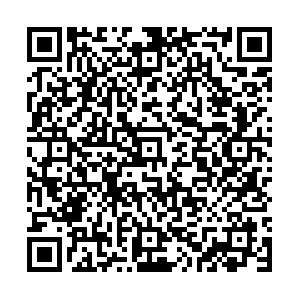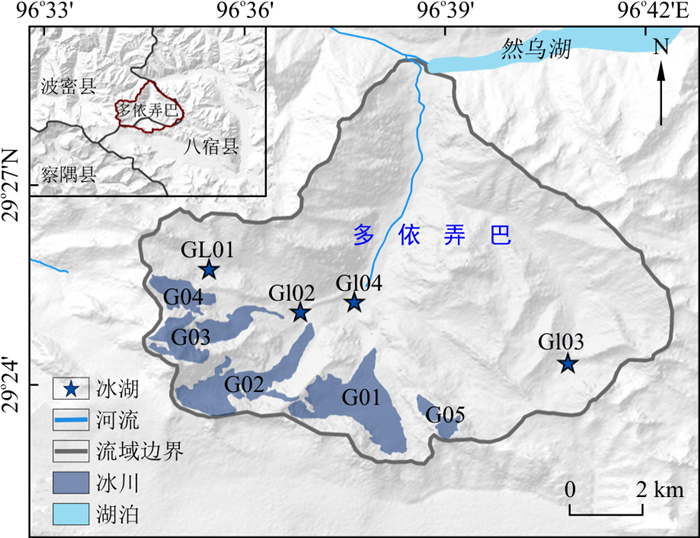Hazard assessment of glacial lake outbursts in the Doyinongba Basin, southeastern Tibetan Plateau
-
摘要:
冰湖溃决灾害是指冰湖坝体突然破坏引发溃决洪水或溃决泥石流的现象,对下游人类活动和自然环境造成严重影响。近年来,藏东南地区冰川快速退缩,冰湖数量和规模显著增加,冰湖溃决事件广泛发生。基于1995-2021年多时相Landsat系列遥感影像、Sentinel-2A遥感影像,结合RAMMS水文动力学模型方法,对藏东南地区多依弄巴流域内冰湖、冰川进行动态变化分析,模拟冰崩危险体触发冰湖溃决和冰湖溃决泥石流的演进过程,根据泥石流模拟中的流速和流深对冰湖溃决可能影响的区域进行危险性分区。结果表明:流域内冰川面积由1995年的14.05 km2退缩为2021年的9.43 km2,年均退缩率约为0.15 km2/a。流域内共发育3处冰崩危险体,均可能触发冰湖溃决。潜在危险冰湖在全溃情况下,溃决泥石流会冲出沟口堵塞然乌湖湖口和帕隆藏布主河道,对下游居民和道路造成影响,影响范围约4.05 km2,其中高危险性区域约2.55 km2。危险性评价结果可为多依弄巴流域未来土地利用规划和防灾减灾提供依据,也能为藏东南地区冰湖溃决型泥石流危险评估提供参考。
Abstract:Glacial lake outburst disasters are the phenomena of outburst floods or debris flows induced by the sudden destruction of glacial lake dams. It has a serious impact on human activities and the natural environment. Recently, the glaciers in the southeastern Tibetan Plateau have retreated rapidly, and the number and scale of glacial lakes have increased significantly, causing frequent occurrences of glacial lake outburst in the southeastern Tibetan Plateau. Dynamic changes in glaciers and glacial lakes, process simulation of the glacial lake outbursts triggered by ice avalanches, and the movement process of glacial lake outburst debris flows were investigated by combining multitemporal Landsat series satellite images, Sentinel-2A satellite images from 1995 to 2021, and the rapid mass movement simulation hydrodynamic modeling(RAMMS). Hazard zoning of debris flow areas was estimated according to the flow velocity and flow depth in the debris flow simulation. The results indicate that the glacial area in the basin shrinks from 14.05 km2 in 1995 to 9.43 km2 in 2021, and the average annual rate of shrinkage is 0.15 km2/a. There are three ice avalanches in the basin, all of which may trigger the collapse of the glacial lake. When the potentially dangerous glacial lake is drained completely, the debris flow rushing out of the ditch may block the mouth of Ranwu Lake and the main river channel of Palongzangbo, posing a threat to the residents and roads downstream. The impact area is approximately 4.05 km2, and the high-risk area is approximately 2.55 km2. The above-mentioned results provide a basis for land use planning, disaster prevention, and mitigation inthe Doyinongba basin, guiding the hazard assessments of glacial lake outburst debris flows in the southeastern Tibetan Plateau.
-
Key words:
- glacial lake outburst /
- RAMMS /
- hazard assessment /
- ice avalanche /
- southeastern Tibetan Plateau
-
表 1 遥感影像来源
Table 1. Source of remote sensing image
获取时间 数据源 波段组合 分辨率/m 1995/11/23 Landsat 5 TM 5, 4, 3 30 1999/09/05 Landsat 5 TM 5, 4, 3 30 2013/09/14 Landsat 5 TM 5, 4, 3 30 2020/08/18 Sentinel-2A 7, 4, 3 10 2021/10/12 Sentinel-2A 7, 4, 3 10 2021/11/07 Landsat 8 OLI 7, 4, 3 30 表 2 泥石流危险性分区划分标准
Table 2. Debris flow hazard zoning standards
危险性等级 最大流深/m 关系 流深乘以最大流速/(m2·S-1) 高 H≥2.5 或 VH≥2.5 中 2.5>H≥0.5 且 2.5>VH≥0.5 低 H<0.5 且 VH<0.5 表 3 冰湖分布及面积变化
Table 3. Distribution and area change of glacier lake
冰湖编号 经度 纬度 高程/m 面积/km2 1995年 1999年 2013年 2021年 GL01 96°35′27″ 29°25′44″ 4 761 0.01 0.01 0.02 0.02 GL02 96°36′46″ 29°24′57″ 4 253 0.01 0.01 0.02 0.02 GL03 96°37′15″ 29°25′15″ 4 068 0.09 0.10 0.11 0.12 GL04 96°40′48″ 29°24′18″ 4 825 0.34 0.33 0.32 0.33 总和 / / / 0.45 0.45 0.47 0.49 变化 / / / / / 0.02 0.02 表 4 冰崩危险体特征
Table 4. Characteristics of glacier avalanches
编号 面积/m3 体积/m3 后缘高程/m 与冰湖高差/m 位置 B01 900 1 924 740 4 820 740 G01冰川末端 B02 900 815 685 4 696 616 G02冰川末端 B03 900 1 103 364 4 828 750 G03冰川末端 -
[1] Cenderelli D A, Wohl E E. Peak discharge estimates of glacial-lake outburst floods and ''normal'' climatic floods in the Mount Everest region, Nepal[J]. Geomorphology, 2001, 40: 57-90. doi: 10.1016/S0169-555X(01)00037-X [2] 沈贝蓓, 宋帅峰, 张丽娟, 等. 1981-2019年全球气温变化特征[J]. 地理学报, 2021, 76(11): 2660-2672. https://www.cnki.com.cn/Article/CJFDTOTAL-DLXB202111006.htmShen B B, Song S F, Zhang L J, et al. Changes in global air temperature from 1981 to 2019[J]. Acta Geographica Sinica, 2021, 76(11): 2660-2672(in Chinese with English abstract). https://www.cnki.com.cn/Article/CJFDTOTAL-DLXB202111006.htm [3] Fabian D, Christian H, ucía G, et al. Managing risks and future options from new lakes in the deglaciating Andes of Peru: The example of the Vilcanota-Urubamba Basin[J]. Science of the Total Environment, 2019, 665: 465-483. doi: 10.1016/j.scitotenv.2019.02.070 [4] Tiberti R, Buscaglia F, Callieri C, et al. Food web complexity of high mountain lakes is largely affected by glacial retreat[J]. Ecosystems, 2020, 23(5): 1-14. [5] Wang S J, Che Y J, Pang H X, et al. Accelerated changes of glaciers in the Yulong Snow Mountain, Southeast Qinghai-Tibetan Plateau. [J]. Regional Environmental Change, 2020, 20(2): 1-13. [6] Sattar A, Goswami A, Kulkarni A V, et al. Future glacial lake outburst flood (GLOF) hazard of the South Lhonak Lake, Sikkim Himalaya[J]. Geomorphology, 2021, 388: 107783. doi: 10.1016/j.geomorph.2021.107783 [7] Su Z, Shi Y F. Response of monsoonal temperate glaciers to global warming since the Little Ice Age[J]. Quaternary International, 2002, 97/98: 123-131. doi: 10.1016/S1040-6182(02)00057-5 [8] Duan H Y, Yao X J, Zhang D H, et al. Glacial lake changes and identification of potentially dangerous glacial lakes in the Yi'ongzangbo River basin[J]. Water, 2020, 12(2): 538. doi: 10.3390/w12020538 [9] 孙美平, 刘时银, 姚晓军, 等. 2013年西藏嘉黎县"7.5"冰湖溃决洪水成因及潜在危害[J]. 冰川冻土, 2014, 36(1): 158-165. https://www.cnki.com.cn/Article/CJFDTOTAL-BCDT201401020.htmSun M P, Liu S Y, Yao X J, et al. The cause and potential hazard of glacial lake outburst flood occurred on July 5, 2013 in Jiali County, Tibet[J]. Journal of Glaciology and Geocryology, 2014, 36(1): 158-165(in Chinese with English abstract). https://www.cnki.com.cn/Article/CJFDTOTAL-BCDT201401020.htm [10] Liu J J, Cheng Z L, Li Y. The 1988 glacial lake outburst flood in Guangxieco Lake, Tibet, China[J]. Natural Hazards and Earth System Sciences, 2015, 11: 3065-3075. [11] Yao T D, Thompson L, Yang W, et al. Different glacier status with atmospheric circulations in Tibetan Plateau and surroundings[J]. Nature Climate Change, 2012, 2(9): 663-667. doi: 10.1038/nclimate1580 [12] Dou X Y, Fan X M, Yunus A P, et al. Spatio-temporal evolution of glacial lakes in the Tibetan Plateau over the past 30 years[J]. Earth System Science Data Discussions, 2021, 354: 1-31. [13] Liu Q, Guo W Q, Nie Y, et al. Recent glacier and glacial lake changes and their interactions in the Bugyai Kangri, Southeast Tibet[J]. Annals of Glaciology, 2016, 57: 61-69. doi: 10.3189/2016AoG71A415 [14] Emmer A, Vilımek V. Review article: Lake and breach hazard assessment for moraine-dammed lakes: An example from the Cordillera Blanca (Peru)[J]. Natural Hazards & Earth System Sciences, 2013, 13(6): 1551-1565. [15] Kougkoulos I, Cook S J, Jomelli V, et al. Use of multi-criteria decision analysis to identify potentially dangerous glacial lakes[J]. Science of the Total Environment, 2018, 621(1): 1453-1466. [16] Rounce D R, Watson C S, McKinney D C. Identification of hazard and risk for glacial lakes in the Nepal Himalaya using satellite imagery from 2000-2015[J]. Remote Sensing, 2017, 9(7): 654. doi: 10.3390/rs9070654 [17] Hang T G, Wang W C, Gao T G, et al. An integrative method for identifying potentially dangerous glacial lakes in the Himalayas[J]. Science of the Total Environment, 2022, 806: 150442. doi: 10.1016/j.scitotenv.2021.150442 [18] Munneeb F. Inventory and GLOF susceptibility of glacial lakes in Hunza River basin, western Karakorum[J]. Remote Sensing, 2021, 13(9): 1794. doi: 10.3390/rs13091794 [19] Sattar A, Haritashya U K, Kargel J S, et al. Modeling lake outburst and downstream hazard assessment of the Lower Barun Glacial Lake, Nepal Himalaya[J]. Journal of Hydrology, 2021, 598: 126208. doi: 10.1016/j.jhydrol.2021.126208 [20] 刘波, 胡卸文, 何坤, 等. 西藏洛隆县巴曲冰湖溃决型泥石流演进过程模拟研究[J]. 水文地质工程地质, 2021, 48(5): 150-160. https://www.cnki.com.cn/Article/CJFDTOTAL-SWDG202105016.htmLiu B, Hu X W, He K, et al. Characteristics and evolution process simulation of the Baqu gully debris flow triggered by ice-lake outburst in Luolong County of Tibet, China[J]. Hydrogeology & Engineering Geology, 2021, 48(5): 150-160(in Chinese with English abstract). https://www.cnki.com.cn/Article/CJFDTOTAL-SWDG202105016.htm [21] Zheng G X, Mergili M, Emmer A, et al. The 2020 glacial lake outburst flood at Jinwuco, Tibet: Causes, impacts, and implications for hazard and risk assessment[J]. The Cryosphere, 2021, 15(7): 3159. doi: 10.5194/tc-15-3159-2021 [22] Wang X, Guo X Y, Yang C D, et al. Glacial lake inventory of high-mountain Asia in 1990 and 2018 derived from Landsat images. [J]. Earth System Science Data, 2020, 12(3): 2169-2182. doi: 10.5194/essd-12-2169-2020 [23] 刘时银, 姚晓军, 郭万钦, 等. 基于第二次冰川编目的中国冰川现状[J]. 地理学报, 2015, 69(1): 3-16. https://www.cnki.com.cn/Article/CJFDTOTAL-DLXB201501002.htmLiu S Y, Yao X J, Guo W Q, et al. The contemporary glaciers in China based on the Second Chinese Glacier Inventory[J]. Acta Geographica Sinica, 2015, 69(1): 3-16(in Chinese with English abstract). https://www.cnki.com.cn/Article/CJFDTOTAL-DLXB201501002.htm [24] 余斌, 何元勋, 刘秧. 冰碛湖溃决易发性的定量评价[J]. 地球科学, 2021, 47(6): 1999-2014. https://www.cnki.com.cn/Article/CJFDTOTAL-DQKX202206008.htmYu B, He Y X, Liu Y. Quantitative susceptibility assessment of the breach of moraine-dammed lakes[J]. Earth Science, 2021, 47(6): 1999-2014 (in Chinese with English abstract). https://www.cnki.com.cn/Article/CJFDTOTAL-DQKX202206008.htm [25] Adam E. Geomorphologically effective floods from moraine-dammed lakes in the Cordillera Blanca, Peru[J]. Quaternary Science Reviews, 2017, 177: 220-234. doi: 10.1016/j.quascirev.2017.10.028 [26] Haeberli W, Schaub Y, Christian H. Increasing risks related to landslides from degrading permafrost into new lakes in deglaciating mountain ranges[J]. Geomorphology, 2017, 293: 405-417. [27] 汤明高, 王李娜, 刘昕昕, 等. 青藏高原冰崩隐患发育分布规律及危险性[J]. 地球科学, 2022, 47(12): 4647-4662.Tang M G, Wang L N, Liu X X, et al. Distribution and risk of ice avalanche hazards in Tibetan Plateau[J]. Earth Science, 2022, 47(12): 4647-4662(in Chinese with English abstract). [28] Somos Valenzuela M A, Chisolm R E, Rivas D S, et al. Modeling glacial lake outburst flood process chain: The case of Lake Palcacocha and Huaraz, Peru[J]. Hydrology and Earth System Sciences Discussions, 2016, 20(6): 1-61. [29] Tiziana B, Peter F, Francesco G. Rheological characteristics of debris-flow material in South-Gargano watersheds[J]. Natural Hazards, 2010, 54(2): 209-223. [30] Nie Y, Liu Q, Wang J D, et al. An inventory of historical glacial lake outburst floods in the Himalayas based on remote sensing observations and geomorphological analysis[J]. Geomorphology, 2018, 308: 91-106. [31] 李德基, 游勇. 西藏波密米堆冰湖溃决浅议[J]. 山地学报, 1992, 10(4): 219-224. https://www.cnki.com.cn/Article/CJFDTOTAL-SDYA199204003.htmLi D J, You Y. Bursting of the Midui Moraine Lake In Bomi, Xizang[J]. Journal of Mountain Research, 1992, 10(4): 219-224(in Chinese with English abstract). https://www.cnki.com.cn/Article/CJFDTOTAL-SDYA199204003.htm [32] Huggel C, Kääb A, Haeberli W, et al. Remote sensing based assessment of hazards from glacier lake outbursts: A case study in the Swiss Alps[J]. Canadian Geotechnical Journal, 2002, 39(2): 316-330. [33] Khanal N R, Hu J M, Mool P, et al. Glaciallake outburst flood risk in the Poiqu/BhoteKoshi/Sun Koshi River basin in the Central Himalayas[J]. Mountain Research & Development, 2015, 35(4): 351-364. [34] 侯圣山, 曹鹏, 陈亮, 等. 基于数值模拟的耳阳河流域泥石流灾害危险性评价[J]. 水文地质工程地质, 2021, 48(2): 143-151. https://www.cnki.com.cn/Article/CJFDTOTAL-SWDG202102017.htmHou S S, Cao P, Chen L, et al. Debris flow hazard assessment of the Eryang River watershed based on numerical simulation[J]. Hydrogeology & Engineering Geology, 2021, 48(2): 143-151(in Chinese with English abstract). https://www.cnki.com.cn/Article/CJFDTOTAL-SWDG202102017.htm [35] 柴波, 陶阳阳, 杜娟, 等. 西藏聂拉木县嘉龙湖冰湖溃决型泥石流危险性评价[J]. 地球科学, 2020, 45(12): 4630-4639. https://www.cnki.com.cn/Article/CJFDTOTAL-DQKX202012024.htmChai B, Tao Y Y, Du J, et al. Hazard assessment of debris flow triggered by outburst of Jialong Glacial Lake in Nyalam County, Tibet[J]. Earth Science, 2020, 45(12): 4630-4639(in Chinese with English abstract). https://www.cnki.com.cn/Article/CJFDTOTAL-DQKX202012024.htm -





 下载:
下载:










